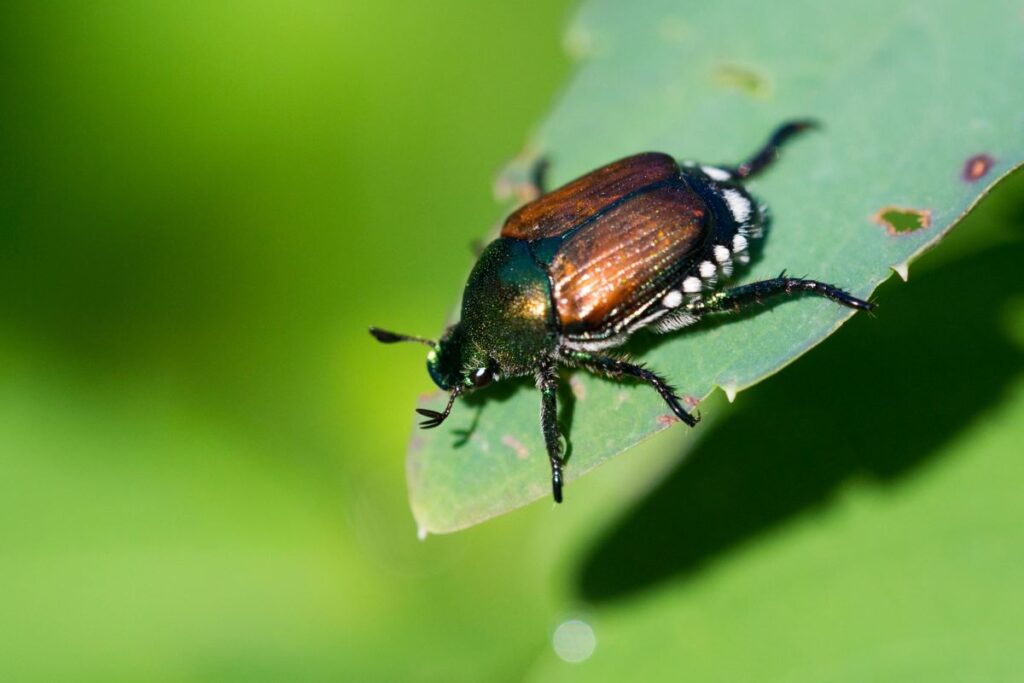Planning your summer garden or admiring the trees in your yard? There’s one visitor you don’t want to welcome this July: the Japanese beetle. These metallic green beetles may look small, but they bring big problems.
If you’ve noticed your leaves turning into lacy, see-through shells, it’s time to take action. Japanese beetles don’t just munch on your favorite trees and plants. They weaken them, make them vulnerable to disease, and spread quickly if left untreated.
About This Invasive Species
Japanese beetles (Popillia japonica) were first discovered in the U.S. in 1916 and have since spread across the eastern half of the country. Though they haven’t made it to Florida, they are firmly rooted here in Wisconsin.
These beetles are less than half an inch long, with shiny, metallic green bodies and coppery-brown wings. You’ll usually spot them in July and August.
What Do Japanese Beetles Damage?
Japanese beetles feed on more than 350 species of plants, but they’re especially fond of:
- Birch
- Elm
- Linden
- Crabapple
- Plum
- Rose
- Mountain ash
They eat between the veins of leaves, creating a skeletonized appearance. It’s not just unsightly. It stresses the tree, reduces photosynthesis, and opens the door to disease.
How to Spot Japanese Beetle Damage?
 Not sure if you have a Japanese beetle infestation? Look for these telltale signs:
Not sure if you have a Japanese beetle infestation? Look for these telltale signs:
- Leaves look skeletonized with only the veins remaining
- Metallic green beetles with white hair tufts along their sides
- Activity beginning in early July and peaking in August
- Beetles swarming in the sunniest parts of your yard
If you’re seeing any of the above, we strongly recommend scheduling a consultation. Timing matters.
Why Traps Can Make It Worse
Many homeowners turn to Japanese beetle traps thinking it will reduce the population. The truth? Traps often attract even more beetles to your yard.
Instead of drawing them in, you want to interrupt their life cycle and protect vulnerable plants through targeted action.
Eco Tree’s Science-Based Treatment Plan
At Eco Tree Company, we don’t believe in guesswork. Here’s how we approach Japanese beetle infestations:
- Full inspection from a Certified Arborist
- Natural fertilizer and soil builder to boost your plant’s defenses
- Targeted chemical treatments if infestation is active
- Immune booster application to support plant recovery
We also educate you along the way, so you can understand what’s happening in your yard and how to care for your trees long-term.
When Are Japanese Beetles Most Active?
Japanese beetles are most active from early July through August. Treating early in the season is critical for:
- Preventing long-term tree stress
- Reducing future infestations
- Supporting the overall health of your landscape
Delaying action allows beetles to spread and cause greater damage.
Signs It’s Time to Schedule Professional Treatment
Give Eco Tree Company a call if you notice:
- Skeletonized leaves
- Shiny beetles on your trees or plants
- Activity increasing in sunny areas of your property
Our Madison-based team understands local trees, pests, and soil conditions. We’re ready to guide you with clear solutions.
Call (608) 886-0626 to schedule your Japanese beetle consultation today.







